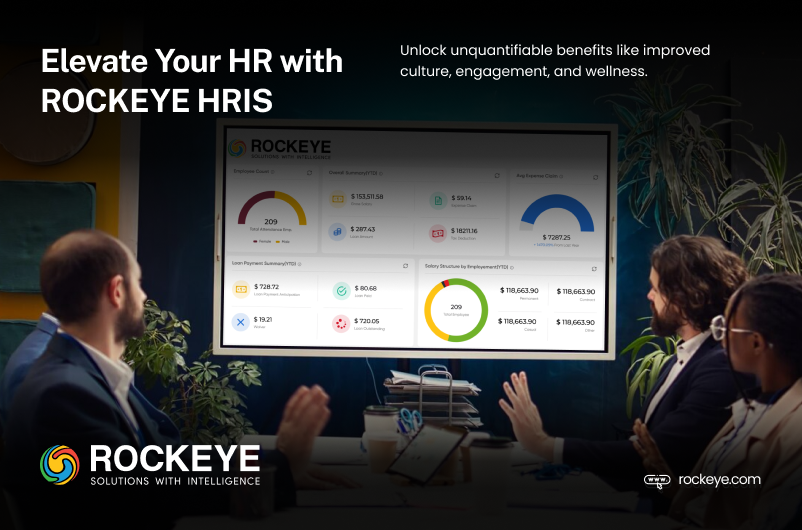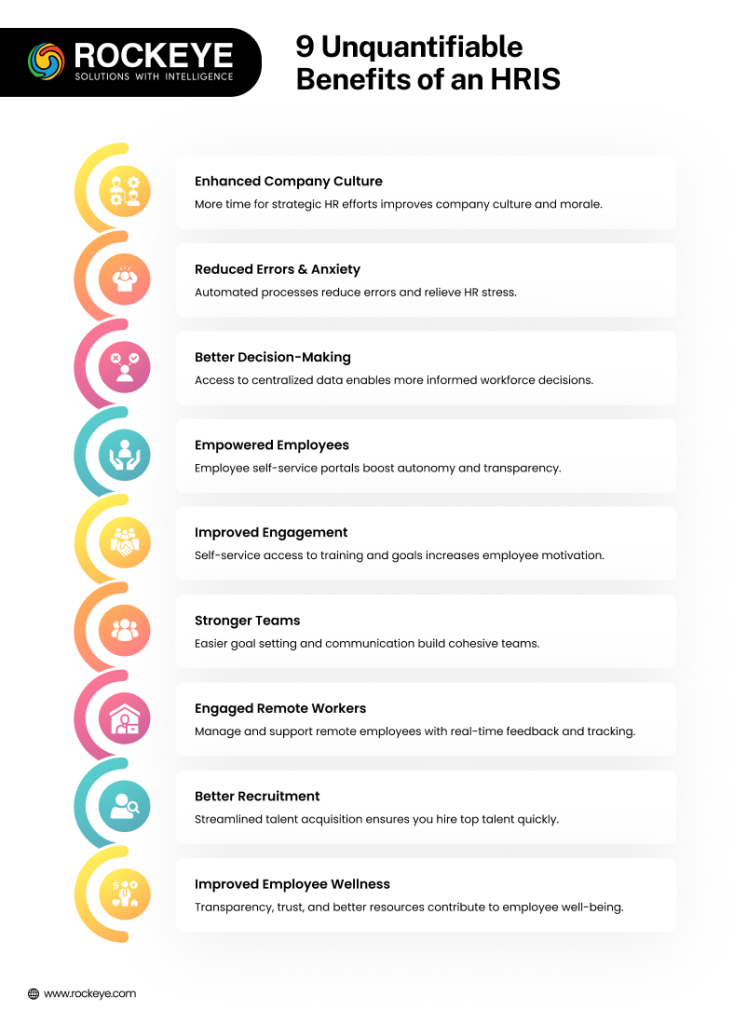The implementation and operation of a Human Resources Information System (HRIS) is a significant investment for an organization.
Key points:
- The right HRIS can deliver significant ROI to an organization.
- HRIS ROI considers quantifiable benefits, including money and time savings.
- It also encompasses valuable, but unquantifiable, benefits of an HRIS for HR professionals, employees, and the organization as a whole.
As is the case with any new software, the implementation and operation of a Human Resources Information System (HRIS), which is part of an HRMS solutions, is a significant investment for an organization. Setup costs, ongoing fees, and training time must be budgeted for. For many organizations, the question becomes: will the HRIS deliver adequate return on investment (ROI)? Will the benefits, in terms of time and money saved, outweigh the software’s costs?

For most organizations, the response is a resounding “Yes.” But by how much? The answer is not easy to pinpoint—and it’s likely much more significant that it appears at first glance.
Below, we’ll take a look at the quantifiable benefits of an HRIS and what that means for its ROI. Then, we’ll delve more deeply into the remarkable, unquantifiable benefits the software can offer—from employee engagement to efficient data tracking.
What is ROI in HRIS?
HRIS ROI is, fundamentally, the business case for implementing HRIS software. Any organization looking to take on a new operational expense wants to know that the cost is justified. HRIS ROI can come in many forms, including:
- Faster onboarding
- Elimination of manual processes
- Automated workflows
- Reduction in repetitive tasks
- Better record keeping
- Improved time-off management
- Benefits that can’t easily be measured, including employee well-being and empowerment (we’ll look more at these below)
If the savings (in time and money) resulting from HRIS implementation are more than the cost of the software, that’s a positive ROI.
How is HRIS ROI calculated?
ROI is generally denoted in one of two ways, both using simple formulas:
1. In percentage: net gain (the amount returned minus the amount invested), divided by the amount invested, multiplied by 100.
2. In dollars: subtract the amount invested from the amount returned.
On the surface, HRIS ROI is no different. To calculate it, you must determine how much money your HRIS will save and the total cost of the software. Use one of the formulas above (or this ROI calculator), and you’ll get a sense of the dollar value an HRIS can bring to your organization.
Our blog post on how to choose an HRIS has a detailed step-by-step guide to calculating HRIS ROI using specific metrics. But to find the true value of implementing an HRIS requires a broader look.
What should be considered about HRIS ROI before implementation
Focusing on the hard, quantifiable benefits of an HRIS, such as the time saved by automating specific tasks and eliminating manual processes, may get you a number to drop into one of the equations above. But you’ll be overlooking some of the most important and valuable benefits that an HRIS can bring to your organization.
For example, you may determine that an HRIS will save the HR department three hours on each employee onboarding cycle. But, can you pin a number on the HR professional’s improved job satisfaction because they get to spend those three hours on more creative and value-added work? Or what that work might mean to your organization? Or is the new hire reduced first-day anxiety because they can review and complete paperwork at home, at their own pace?
Below we explore some of the other remarkable, unquantifiable benefits of an HRIS.
9 Unquantifiable Benefits of an HRIS
It’s difficult or impossible to assign a dollar figure to any of the benefits discussed below, but they are important components of your HRIS ROI, and worthy of your consideration.

1. Enhanced company culture
If an HRIS takes over certain tedious, administrative tasks—such as collecting paperwork and manually entering personal data—the HR team can spend more time thinking about people. They might create policies or initiatives to bolster company culture or boost morale. This includes planning events that align with the organization’s vision. HR professionals can better track, notice, and proactively respond to trends in employee behavior.
An HRIS can also foster connection and communication through data sharing, information access, and news and message boards.
2. Reduced errors, reduced anxiety
An HRIS can help:
- Ensure compliance data security requirements
- Stay up to date on various state and federal tax laws
- Centralize information
- Automate tasks
- Create predesigned workflows
All of these features, among others, reduce the chances of human error. Reducing errors saves time and money, but also reduces stress and lets the HR team move forward with confidence (and have a good night’s sleep).
3. Better decision-making
Because an HRIS records and tracks all employee data and information in one location, it offers an opportunity for insightful employee analytics (metrics in productivity, retention, salary, time-off used, achievements, and more). Employee surveys can be created, feedback is collected, and accurate reports are generated.
All this data can be leveraged for better short- and long-term decision-making, workforce planning, and strategizing—improvements that are hard to quantify but are priceless.
Also Read: 16 Must-Have Features for an Effective Attendance Management System
4. Empowered employees
The employee self-service portal is a critical feature of most HRIS systems. The portal allows employees to fill out benefits and other forms at home, in private, to read through and complete documentation at their leisure. Employees can look up company information and policies at any time. They can also view and manage their personal information, time-off requests, benefits, and perks.
This kind of transparency and ease of access increases trust, helping employees feel valued and empowered.
5. Improved engagement
Through the HRIS’s self-service portal, employees can also access training resources, and track progress toward educational or workplace goals in real-time. This can inspire employees to take further training and motivate them to hit targets.
Removing red tape and administrative processes also builds better connections and communication between the employee and human resources team.
6. Stronger teams
Teams will also benefit from an HRIS through shared goal-setting and tracking, and easier communication with colleagues. Collaborators can accurately plan and work toward a common project outcome.
The HR team, in particular, will benefit from standardized processes and a single, centralized repository of data—making working in sync simple.
7. Engaged remote workers
An HRIS is indispensable for managing remote workers. Real-time feedback, schedulers, and productivity tracking ensures remote employees, team leaders, and managers are all on the same page and communicating well. Time and attendance monitoring system
features let teams (and the HR department) know when remote employees are available.
Having a solid plan for remote worker management is also a competitive advantage, allowing companies to offer hybrid or work-from-home arrangements, and/or recruit talent unrestricted by location.
8. Better recruitment
You’ll never know the value of the star employee you didn’t hire. An HRIS can greatly streamline the talent acquisition process, from job posting to sorting resumes and targeting the best candidates. According to LinkedIn, top talent is only on the market for about 10 days, recruiting has to be efficient and precise.
Hire the right person, and your efforts will be rewarded—but a mis-hire can be costly and exhausting.
9. Improved employee wellness
All of the above contribute to one major, unquantifiable benefit: improved employee wellness. Whether it’s through a more transparent performance review process, better defined goals, the elimination of tedious tasks, increased access to resources, or a warmer company culture, the right HRIS can make a real difference.
According to Harvard Business Review, about 80% of workers say they’ve encountered at least one workplace factor that negatively affected their mental health. These factors include excessive workloads, stress, and poor communication. No software is going to solve all wellness concerns. But transparency, trust, communication, and clear expectations all contribute to employee satisfaction and, as a result, retention. An HRIS is a valuable tool toward this goal.

FAQs
1. What is an HRIS?
An HRIS, or Human Resources Information System, is a specialized software that helps companies manage key employee data such as payroll, benefits, and recruitment.
2. Why should businesses invest in an HRIS?
An HRIS can help companies save time and money by streamlining tasks. It aids in keeping everything organized and can boost employee job satisfaction.
3. How do you figure out the ROI of an HRIS?
To work out the ROI of an HRIS, you compare the money and time the system saves to its purchase and running costs. You can show this as a percentage or in dollars.
4. What are some clear benefits of using an HRIS?
An HRIS makes hiring faster, cuts down on repetitive work, keeps records better, and simplifies time off management.
5. What are some benefits of an HRIS that are hard to measure?
These tricky-to-quantify perks include a stronger company culture fewer errors smarter choices, and more satisfied staff who feel more involved and in control.
6. How does an HRIS help keep employees engaged?
An HRIS lets workers control their own data, access training resources, and link up more with HR, which helps them feel more connected to their jobs.
7. Can an HRIS help manage remote workers?
You bet! An HRIS works wonders for remote employee management. It gives you tools to check in, keep tabs on attendance, and help everyone stay connected.
8. How does an HRIS contribute to employee wellness?
An HRIS makes things run smoother and cuts down on stress. This leads to a better work environment. The result? Employees feel happier and less stressed out.
9. What should I look for in an HRIS?
When you’re shopping for an HRIS, keep an eye out for certain key features. Look for one that’s user-friendly, takes care of repetitive tasks, churns out helpful reports, and boosts communication between employees.
10. Is it worth it to put an HRIS into action in my business?
Most businesses find that the benefits of using an HRIS—both the measurable and intangible ones—far outweigh the costs making it a wise investment.
- better decision-making
- company culture
- data security
- employee empowerment
- employee engagement
- employee wellness
- HR automation
- HR software
- HRIS benefits
- HRIS implementation
- HRIS recruitment
- HRIS ROI
- human resources information system
- remote worker management
- talent acquisition
- unquantifiable benefits

